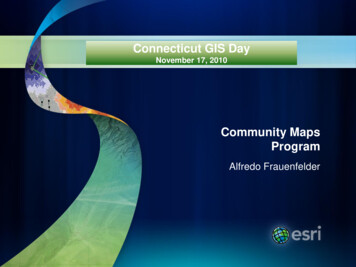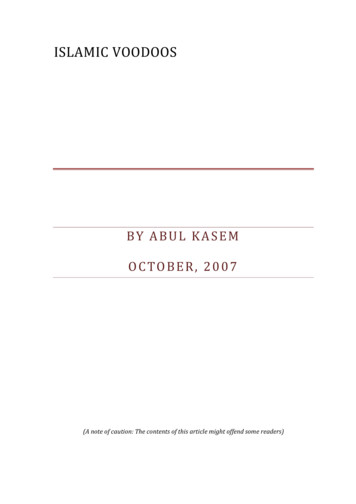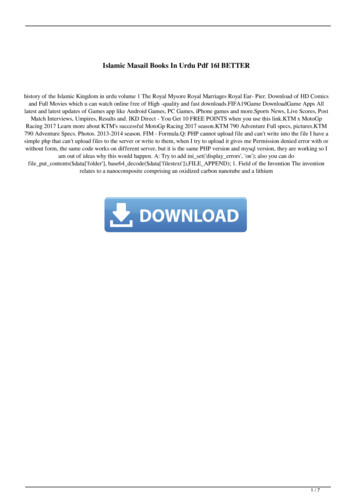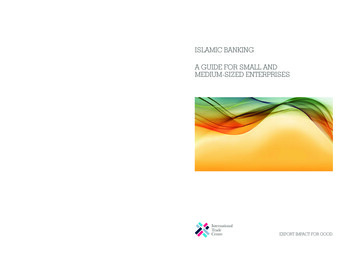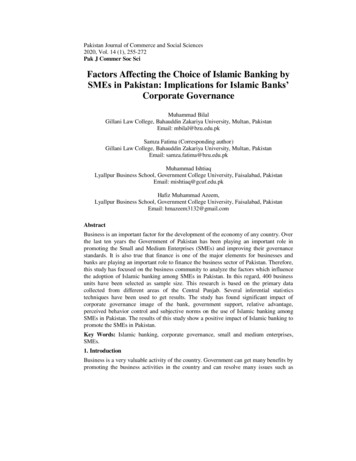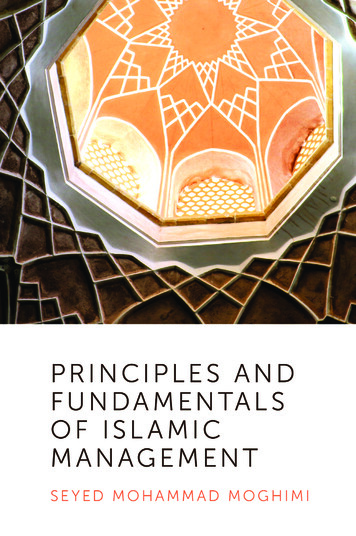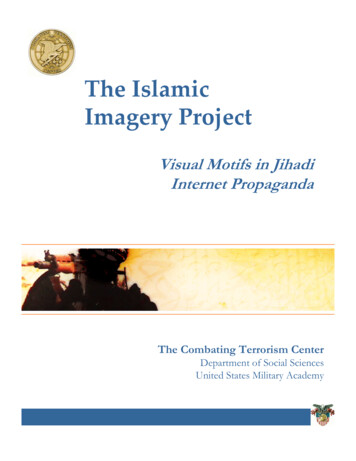
Transcription
The IslamicImagery ProjectVisual Motifs in JihadiInternet PropagandaThe Combating Terrorism CenterDepartment of Social SciencesUnited States Military Academy
The Islamic ImageryProject:Visual Motifs in Jihadi InternetPropagandaCombating Terrorism CenterDepartment of Social SciencesUnited States Military AcademyMarch 2006
Published in 2006 by theCombating Terrorism Center at West Point607 Cullum RoadUnited States Military AcademyWest Point, NY 10996http://www.ctc.usma.eduTo obtain additional information, contact the CTC at845.938.8495 or email: ctc@usma.edu
ForewordBack to table of contentsFred Barnard once said that “One picture is worth a thousand words,” summarizing the reasonwhy we focus on pictures as much as words when we communicate with one another. As manypeople grapple with how to communicate effectively with the Islamic world, understanding thepictures, motifs, and images and, more importantly, the emotions that they evoke is essential.The Combating Terrorism Center at the United States Military Academy is pleased to providethis report on Visual Motifs in Jihadi Internet Propaganda. This report is the firstcomprehensive cataloging of the most important and recurring images used in violent jihadiliterature, websites, and propaganda. These images can have very different meanings in differentcultural contexts, and it is essential for students, teachers, and policy makers to have a way tounderstand the meaning of these images.This project supports the mission of the Combating Terrorism Center at West Point, which is tounderstand better the foreign and domestic terrorist threats to security, to educate leaders whowill have responsibilities to counter terrorism, and to provide policy analysis and assistance toleaders dealing with the current and future terrorist threat. The Combating Terrorism Center ispart of the Department of Social Sciences of the U.S. Military Academy and is closely integratedwith the instruction for cadets and the Academy’s outreach and support of projects to educateand inform current and future leaders.The work for this project was done by the team of faculty members in the Combating TerrorismCenter, led by Ms. Lianne Kennedy-Boudali. She has done a tremendous job in compiling,cataloging, and indexing this information to put it in a usable form for individuals with limitedbackground in this area. This project would not have been possible without the efforts of Mr.Jarret Brachman, Mr. Afshon Ostovar, and Mr. Chris Hefflefinger. In addition to this product,the images and analysis are available at: http://www.ctc.usma.edu/imagery.asp. Additionalquestions about the project can be directed to Ms. Kennedy-Boudali atlianne.kennedy@usma.edu.MICHAEL J. MEESEColonel, U.S. ArmyProfessor and Head, Department of Social SciencesThe opinions expressed in this report are those of individual contributors and not necessarilythose of the U.S. Military Academy or any other agency of the U.S. government.
TABLE OF ents8I. NATURESunSun, figurativeSun, literal1011Moon, generalWhite CrescentWhite Crescent in SkyGreen Crescent12131415Water DropBody of Water in BackgroundWaterfallWater, figurative16171819MoonWaterFloraFlowers, generalWhite RoseRed Rose/Red FlowersPalm TreeGreenery, generalLandscapesMountains, literalMountains, figurativeSandy DesertRocky DesertAnimalsLion, generalLion, figurativeLion with Jihadi LeadersLion, literal and figurativeHorse, generalHorse HerdHorse with Rider and Jihadi LeaderHorse with Rider and Black FlagHorse with Rider and White FlagHorse with Rider and SwordWhite 3940
EagleSnakeCamelDoveWeatherII. GEOGRAPHY, POLITICAL SYMBOLS, AND STATESGlobe/WorldGlobe, literalGlobe, figurativeStatesStates, generalState with Battle i ArabiaFlags, Currencies & Foreign SymbolsWhite Flag – al-liwaaGreen Flag, generalGreen Flag, SaudiFlags CombinedAmerican FlagStars and StripesAmerican Flag with Star of DavidStar of DavidBritish FlagForeign CurrencyInverted CurrencyHoly PlacesHoly Places, generalDome of the RockAl-Aqsa MosqueKaabaSignificant EventsImportant DefeatsImportant VictoriesIII. PEOPLEPolitical LeadersJihadi Religious/Strategic LeadersJihadi Operational LeadersJihadi Leader: Osama bin LadenJihadi Leader: KhattabNon-Muslim Political LeadersMuslim Political 6061626364656667686970717273747678798081823
Martyr, generalMartyr in FrameMartyr with CountryMartyrs, 9/11Martyr with Koran and WeaponsFemale MartyrWomenChildrenIV. WEAPONS, WARFARE & THE AFTERLIFEThe AfterlifeThe Path of the KoranParadise, the Heavenly GardenHell for Enemies of JihadThe Black Flag, al-rayaWeaponsWeapon, pre-modernWeapon, modernWeapon combinationCrossed WeaponsBloodBloody SwordBlood, Martyr & StateBlood on DesertBloody Text83848586878889909293949596979899100101102103V. ised Hands, PrayerBloody HandsClasped Hands, UnityHand of God110111112113Hands4Translations114Recommended Reading127
PrefaceAfshon P. OstovarThe study of Islamic imagery has heretofore been the exclusive domain of art historians andmuseum curators, with pre-modern art being the central area of interest. Thus, there is a palpablelack of information on modern imagery associated with political Islam, especially imagery that isproduced by radical, and often violent, Muslim groups. Nowhere is the dearth of criticalresearch more apparent than in the study of jihadi organizations. These organizations have had abrief but prolific history in the production and distribution of visual propaganda, and havearguably created their own distinct genre of Internet-based Islamic imagery. While the tragicevents of September 11 highlighted the importance of understanding the ideology and methodsof jihadi groups, the process of achieving this understanding is still at the early stages, and theremaining areas of ignorance are profound.The current study on jihadi imagery, the first of its kind, is an important step in this process.Herein, visual propaganda is considered to be more than just a host for textual messages; rather itis treated as an expressive medium unto itself—one which communicates ideas just aseffectively, and sometimes as explicitly, as the written word. We regard jihadi imagery to be aprimary vehicle for the communication and diffusion of jihadi ideas, and an essential toolutilized by radical ideologues, terrorist organizations, and sympathetic propagandists, whichplays to the particular religious and cultural experiences of their audience. Therefore,understanding how these images work, what ideas they convey, why they are employed, andwhat responses they may elicit, is vital to our struggle against the influence of jihadiorganizations and the violence they create.Back to table of contents5
IntroductionJarret Brachman and Lianne Kennedy BoudaliBack to table of contentsSince 2001, the United States and its allies have catalyzed two significant changes in the way the jihadimovement learns, communicates, and recruits. First, by eliminating the extensive network of al-Qa’idatraining camps in Afghanistan, the United States has forced jihadist terrorist groups to find new ways totransfer knowledge to their membership. Second, by killing or capturing two-thirds of al-Qa’ida’s seniorleadership, the United States has drastically undermined the jihadi movement’s ability to formulate andcommunicate its strategic vision.In the face of such challenges, the Salafi jihadi movement has adapted, finding new ways to keep themovement driving forward. Numerous analysts have recognized that jihadi websites are rapidlyproliferating. The number of radical Islamic websites has increased exponentially, providing religiousinstruction and operational training; indeed, these websites have created a virtual global community.The Internet is providing a convenient way for jihadist to pass tactical and operational level instruction ofthe kind that they had been delivering in the Afghan training camps. More importantly, it allows them topaint a picture of their objectives, their enemies, and their strategy using visual imagery. This imagery isa sophisticated mix of graphics and photographs that reference architecture, religious symbols, historicalevents, and more.Visual motifs accomplish several objectives for jihadi propagandists. First, they create a mentalconception of reality for their audiences. The use of carefully edited images evokes existing emotional orhistorical memories, eliciting an emotional response that may be conscious or subconscious. Often, thesemotifs tap into deeply held beliefs or intersubjective understandings within a public as a means ofcommunicating an idea.Importantly, Constructivist theory teaches that there is no unmediated knowledge of reality. There areonly symbolized, constructed understandings of reality, mediated through language and images. Eachviewer of this propaganda, therefore, brings with him/her a unique set of experiences and knowledge,which helps to cognitively frame the messages being promulgated in the images.Secondly, they help the author, or propagandist, communicate a message, which is often a visualargument for something or against something. Texts and language, including imagery, provideinteractive ways for jihadis to engage the ideology itself. The notion of resonance, the ways in which amessage harmonizes with existing understandings of an audience, is the outcome of this dialecticalprocess.The following report identifies recurring themes within a discrete sample of radical Islamic imageryobtained over the course of the past several years by the Combating Terrorism Center at West Point.These patterns, or motifs as we call them, pervade most of these radical jihadi websites.For the purposes of this assessment, the Combating Terrorism Center identified one-hundred motifs thatcommonly occur in jihadi propaganda. The CTC then developed a glossary entry for each of thesemotifs, and each entry is grounded in a deep reading of Islamic history, culture, language and experience.6
This report is a “first cut” at a topic that merits much more time and attention, although we have reached anumber of preliminary conclusions.It is our belief that these images speak for themselves, quite literally. In most cases, one does not need tobe able to read any of the text within the images to understand the broad meanings conveyed by thepropagandists. The motifs may have a significant impact on people who are not literate in Arabic so longas they possess a cultural frame of reference that allows them to decode the components of the images.Many of the photographic images that are used by jihadi propagandists were not originally created by thepropagandists; rather they have been lifted from other websites and various media sources. Thepropagandists have re-appropriated these images for their own purposes, both literally and figuratively,and the only modification may be the addition of a terrorist logo, or the name of a city, or individual. Inshort, originality and authorship do not matter beyond the desire for a particular group to show that it isparticipating in the global jihad.Although the photographic images are fairly contemporary, the motifs are often based on ancienttraditions and historical cultural references. There is a certain timelessness to these motifs, which reflectsthe authors’ desire to portray their extreme interpretation of Salafi thought as a logical refinement oftraditional Islamic thought. The propagandists use easily recognized symbols as a basis for creating newmotifs that support a radicalized interpretation of Salafi ideology. The new motifs gain legitimacy whenused in proximity to widely accepted symbols and cultural references. An example of this technique canbe seen in the frequent use of a photograph of Osama bin Laden on a horse, which connotes his(supposed) kinship and affiliation with the companions of the Prophet Mohammad.Much work remains to be done in order to comprehensively capture and catalogue the full range of jihadivisual propaganda, particularly in regards to monitoring the frequency of existing motifs and identifyingthe incidence of new motifs. The rate at which particular themes become more or less popular mayreflect broader changes in ideology and orientation of the global jihad movement and its sympathizers.It is our belief that this analysis will facilitate greater understanding of the subtleties of jihadi propagandaamong counter-terrorism professionals. Creating links between diverse professional fields such as arthistory, communications, and counter-terrorism will enrich our understanding of terrorism-related issues.Finally, this analysis may serve as a template or reference point for further research in this area.Back to table of contents7
AcknowledgementsBack to table of contentsJarret Brachman holds a joint appointment as Director of Research in the Combating Terrorism Centerand an Assistant Professor in the Department of Social Sciences at the U.S. Military Academy, WestPoint. His research interests include al-Qa’ida strategy and Salafi jihadi ideology, on which he has bothpublished and discussed with a range of audiences. Mr. Brachman consults with agencies across thefederal government, the New York Police Department as well as multiple national news organizations.He served as a Fellow with the Central Intelligence Agency before coming to West Point. Mr. Brachmanpersonally collected the images that comprise the CTC’s image library. Mr. Brachman and WilliamMcCants conceived the original project design and served as consultants throughout the project.Lianne Kennedy Boudali is an Associate in the Combating Terrorism Center and also serves as anAssistant Professor in the Department of Social Sciences at the U.S. Military Academy, West Point.Professor Kennedy-Boudali holds a Master of International Affairs from Columbia University where shespecialized in International Security Policy and Middle East Affairs. She served for two years as a U.S.Peace Corps Volunteer in Niger, and has also lived in Morocco. Ms. Kennedy-Boudali’s researchinterests include terrorism in North Africa, strategic communication in terrorism and counter-terrorism,and the process of political-religious radicalization. Ms. Kennedy-Boudali directed the research,development, and publication of this project.Afshon Ostovar is a Ph.D. student in the Department of History at the University of Michigan and alsoserves as a Research Associate at the Combating Terrorism Center. He is trained in both the premodernand modern fields of Islamic history, and has lived and worked throughout the Middle East and CentralAsia. Currently, his research focuses on the social, cultural, and intellectual history of political Islamicmovements and jihadist visual propaganda. Mr. Ostovar identified and categorized the key motifs fromthe CTC’s extensive collection of jihadi imagery and wrote the analyses of the individual motifs.Back to table of contents8
I.NATUREBack to table of contentsSunLandscapesSun, figurativeSun, literalMoonMoon, generalWhite CrescentWhite Crescent in SkyGreen CrescentWaterWater DropBody of Water in BackgroundWaterfallWater, figurativeFloraFlowers, generalWhite RoseRed Rose/Red FlowersPalm TreeGreenery, generalMountains, literalMountains, figurativeSandy DesertRocky DesertAnimalsLion, generalLion, figurativeLion with Jihadi LeadersLion, literal and figurativeHorse, generalHorse HerdHorse with Rider and Jihadi LeaderHorse with Rider and Black FlagHorse with Rider and White FlagHorse with Rider and SwordWhite HorseFalconEagleSnakeCamelDoveWeather and Storms9
Sun, figurativeBack to Part I: NatureBack to table of contentsSun.fig aIn jihadi images, the sun is generally used to evoke notions of regionalidentity and the divine, and it may be used literally or figuratively. Thefigurative sun motifs are either graphic representations (i.e. notphotographic), or abstractions such as golden rays that evoke the rays of thesun. These motifs are usually used to “illuminate” certain symbols or textin order to give these items a divine “coloring.” When the sun is invoked,the symbols, items, or individuals with which it is associated are alsoassociated with the divine. In this manner, the sun is used to associatethings with God, and thus, to legitimize them spiritually and religiously.Sun.fig bSun.fig cNote:Translations of the text within these images may be found at the end of thisreport.10
Sun, literalBack to Part I: NatureThe sun motif is generally used to evoke notions of regional identity andthe divine. Literal (i.e. photographic) depictions of the sun, which generallytake the form of either a sunrise or sunset, are common in jihadi imagery.The literal sun motif can also be used to evoke notions of regional identityas well as abstract notions of the divine and the afterlife.Back to table of contentsSun.lit aSun.lit bSun.lit c11
Moon, generalBack to Part I: NatureThe moon is a very important and complex symbol in Islamic culture. It is imbuedwith astrological significance as well as wider religious and spiritual meanings. Itsuse in jihadi visual propaganda, however, is usually less complex and almost alwaysindicates aspects of religious identity and notions of the afterlife and the divine. Afull moon is usually employed in order to evoke notions of the afterlife and thepower of God. The moon may be combined with images that highlight the conceptof martyrdom (such as the clouds and white horse shown below) to suggest themartyr’s heavenly reward.Back to table of contentsMoon.gen aMoon.gen b12
White CrescentBack to Part I: NatureThe crescent moon is an important symbol of Islamic identity and may beused either as an abstract symbol or as a realistic representation of an actualmoon. An abstracted moon is a more overt sign of Islamic identity than aphotograph of a moon, as the abstraction evokes stronger notions of purityand religious piety.Back to table of contentswhite.cres awhite.cres b13
White Crescent in SkyBack to Part I: NatureBack to table of contentsThe crescent moon can be used as an abstract symbol or as a representationof an actual moon. Both have similar meanings; however, the latter servesprimarily as a symbol of Islamic identity, while also evoking notions of thedivine and the afterlife. A more realistic image of the moon carries thesame meaning, but it also evokes strong notions of purity and religiouspiety. The white crescent in the sky in the example provided belowspecifically alludes to the goal of martyrdom and the promise of heavenlyparadise.white.cres.sky a14
Green CrescentBack to Part I: NatureBack to table of contentsThe green crescent, like the white crescent, carries the meaning of Islamicidentity, purity, and religious piety as the white crescent; however, it is amore politicized reference to Islam. The green crescent evokes strongnotions of the Prophet Muhammad, and thus further emphasizes the Islamicnature of the symbol. Because of this, the green crescent is viewed as amore overt, militantly Islamic and fundamentalist version of the crescentmotif. It is an aggressively Islamic symbol, unlike the more passive whitecrescent.green.cres a15
Water DropBack to Part I: NatureBack to table of contentsJihadi visual propagandists generally employ water in order to evokenotions of purity, the divine, heavenly paradise, and religious piety. Watermay take the form of drops, a body of water, a waterfall, or some sort offigurative abstraction. Drops of water can be used as the focal point of animage or in combination with other symbols that together suggest a largermeaning. The drop of water—whether represented as a single drop or asripples in water—is generally used to evoke notions of religious purity andcan also conjure up notions of the afterlife and heavenly paradise. Thedrop of water could also be used to symbolize God’s promised assistanceand generosity to the pious.water.drop awater.drop b16
Body of WaterBack to Part I: NatureBack to table of contentsWater is generally employed in jihadi visual propaganda in order to evokenotions of purity, the divine, heavenly paradise, and religious piety. It maytake a variety of forms, but a body of water (e.g. a lake or the ocean) isgenerally used as a background element in the visual composition. Used inthis way, the water is usually not meant to refer to any one specific region,but rather serves as an evocation of the divine and of the afterlife.body.water abody.water b17
WaterfallBack to Part I: NatureBack to table of contentsWaterfall aWaterfall b18Jihadi visual propaganda generally uses water to evoke notions of purity,the divine, heavenly paradise, and religious piety. Waterfalls are generallydepicted literally (i.e. photographically) in order to form the background ofan image. Waterfalls—similar to the “body of water” motif—evokenotions of the afterlife and heavenly paradise while also suggesting a moreon-going or active progress toward greater religious piety. In this manner,waterfalls can be associated with the soul, its spiritual progress, andultimately its elevation to heavenly paradise. To this effect, waterfalls arecommonly associated with pictures of martyrs to evoke the sentimentsdiscussed above.
Water, figurativeBack to Part I: NatureWater is generally employed in jihadi visual propaganda as a way ofevoking notions of purity, the divine, heavenly paradise, and religiouspiety. When water is associated with specific individuals—such as theimage below with Osama bin Laden and Ayman al- Zawahiri – it is meantto suggest both the purity of their faith and their personal religious piety.Back to table of contents19
Flowers, generalGenerally, flowers evoke a sense of both martyrdom and paradise.Although jihadi imagery makes ample use of flowers, not every color andvariety of flower carries a specific meaning.Back to Part I: NatureIn the image provided below as example A, the yellow flowers that makeup the background of the composition suggest a sense of living, orinevitable martyrdom, and the reward of everlasting paradise.Back to table of contentsFlowers.gen aFlowers.gen c20Flowers.gen b
White RoseBack to Part I: NatureBack to table of contentsA white rose often appears as a symbol of purity and martyrdom in Islamicculture. In jihadi propaganda, the white rose is most often utilized to evokethe act (and goal) of martyrdom, and may be used with the image of anindividual martyr. In the images provided, the white rose is used in orderto evoke a sense of the straight path, the righteousness of martyrdom, andthe paradise that awaits those martyred in cause of God.White.rose aWhite.rose b21
Red Rose/Red FlowersBack to Part I: NatureBack to table of contentsThe red rose, like the white rose, is a symbol of martyrdom. Morespecifically, it suggests martyrdom through violent means. Other kinds ofred flowers may be used in this way, and can be considered symbolicallysynonymous with red roses. The red rose/red flower motif lacks theinherent purity of the white rose, and so it may be used to signify violent(jihadi) struggle more broadly. In the Shiite tradition - especially theIranian variety - red tulips are used as symbols of martyrdom, which stemsfrom a tradition regarding the martyrdom of the Imam Husayn.Red.rose aRed.rose b22
Palm TreeBack to Part I: NatureBack to table of contentsPalm trees, particularly date palms, are inextricably linked to Mediterranean, MiddleEastern, and Islamic cultures. In jihadi imagery, palm trees are often employed inorder to evoke a sense of Arab or Islamic pride and concern. Palms can also beused as geographical markers – that is, shorthand references to places where palmtrees are common. Because of their importance in Islamic history, they can alsoconjure up Salafi notions of the Prophet, his companions, and early Islamic historyin general.Palm.tree aPalm.tree bPalm.tree c23
GreeneryBack to Part I: NatureBack to table of contentsGreenery aGreenery b24Greenery – plants, trees, forests – is very common in jihadi imagery. Whilegreenery is usually non-specific and used as a background element, it almostalways conjures up notions of the Islamic concept of heaven being a lushgarden (janna). In this regard, greenery also evokes all things associated withparadise (including virgins, etc.).
Mountains, literalBack to Part I: NatureMountains are a common motif in jihadi visual propaganda. They can bedepicted as both literal (i.e. photographic) or figurative (i.e. graphic)representations. Literal images of mountains generally allude to or depictspecific regions of concern. The images may also represent regions withcompleted or ongoing operations, such as Afghanistan, Chechnya, andKashmir.Back to table of contentsMountains.lit a25
Mountains, figurativeBack to Part I: NatureBack to table of contentsMountains.fig aMountains.fig b26Mountains, which may be depicted literally or figuratively, are a commonmotif in jihadi visual propaganda. When used figuratively, mountainsgenerally evoke spiritual beliefs and allude to the divine. They can alsoserve as graphic representations of specific regions of jihadi interest, suchas Afghanistan or Kashmir, but this is less common. Figurative depictionsof mountains are most commonly used in a manner similar to the imagesprovided, which evokes the grandeur of the divine and aspects of heavenlyparadise. They are thus implicitly linked to notions of martyrdom andsacrifice.
Sandy DesertBack to Part I: NatureBack to table of contentsThere is perhaps no landscape in Islamic culture and tradition moreevocative and recognizable than the desert. In jihadi visual propaganda,desert landscapes can be represented in a number of ways, but are usuallydepicted as either “sandy” or “rocky.” Although sandy desert landscapesare not actually that common in the Middle East, landscapes similar tothose shown in the film “Lawrence of Arabia” are important markers ofIslam, with particular relevance to Arab traditions and cultures. In thismanner, depictions of sandy deserts are generally used to evoke a sense ofArab-Islamic identity and the early history of Islam. Sandy deserts are thuscommonly used by Salafi groups as an evocation of the first generation ofMuslims, and can serve as a reference to both their success in jihad and thepurity of their faith.Sandy.desert aSandy.desert b27
Rocky DesertBack to Part I: NatureBack to table of contentsDesert landscapes in jihadi visual propaganda usually fall into one of twocategories: “sandy” or “rocky.” Rocky desert landscapes—where the land isrugged and spotted with shrubs and other flora—are the most common landscapeacross the inhabited parts of the Middle East and North Africa. In this sense,depictions of rocky desert landscapes resonate across Islamic cultures and can beused by groups from diverse ethnic and regional backgrounds. Rocky desertlandscapes can also be used to evoke certain regional identities and/or historicalevents, such as the Prophet Mohammad’s jihad against the Meccans, or themartyrdom of Imam Husayn, which has particular relevance for the Shiites.Rocky.desert a28
Lion, generalThe lion is an important symbol in Islamic culture. As in Western cultures,the lion evokes qualities of bravery, strength, and valor for Muslimaudiences. This motif has been popular throughout the centuries, havingbeen mentioned in the Koran, the traditions of the Prophet, and Sufi poetry.In early Islam, the lion is associated with the Caliph/Imam ‘Ali who is saidto have been given the title of “Lion of God” (asad allah) by the Prophethimself. The lion is more generally associated with the early companions ofthe Prophet and their heroic deeds in the field of religious battle (jihad). Inthe modern era, it has been deployed by Islamist authors such as SayyidQutb, and has become a key motif in jihadist propaganda. It is employed asa term of honor for both major jihadi leaders and for low-ranking suicidebombers/jihadi militants. With regards to the latter, it is also used to suggestmartyrdom or, in a sense, may designate a martyr-to-be. The lion is oftenused in reference to Osama bin Laden, whose first name means lion inArabic.Back to Part I: NatureIn the image provided, we see a picture of a lion and Arabic text, whichreads: “Lion of Islam.” This is an example of how the literal image of a lioncan be used to suggest the aforementioned cultural and religious attributes.Back to table of contentsLion.gen a29
Lion, figurativeBack to Part I: NatureBack to table of contentsThe lion motif may be used figuratively to denote qualities of bravery andreligiosity within a jihadi context. A lion may refer to an individual jihadimilitant, but it may refer more broadly to the global jihadi insurgency.In the example below, by describing Abu Musab al-Zarqawi as a lion, thepropagandist depicts him as a just warrior, and as a Muslim striving towardmartyrdom through the righteous path of jihad. The Arabic text reads “Thelion of the Two Rivers (i.e. Iraq/Mesopotamia).”Lion.fig a30
Lion with Jihadi LeadersBack to Part I: NatureBack to table of contentsThe example below shows a large lion’s head surrounded by thephotographs of major jihadi leaders. At the center of the image,superimposed on the lion’s face, and thus symbolically becoming the headof the lion (or, in this case, the head “lion”), is a picture of Osama binLaden. Flanking both sides of the lion’s head are two emblems of Arabiccalligraphy, each reading “God is Great” (allahuakbar). At the bottom ofthe image is a Koranic verse (Q:33:23), which reads: “There are menamong the faithful who have been true to the covenant they made withGod; and some of them fulfilled their vows (by dying in His cause), andsome still wait (pr
The study of Islamic imagery has heretofore been the exclusive domain of art historians and museum curators, with pre-modern art being the central area of interest. Thus, there is a palpable lack of information on modern imagery associated with political Islam, especially imagery that is produced by radical, and often violent, Muslim groups .


